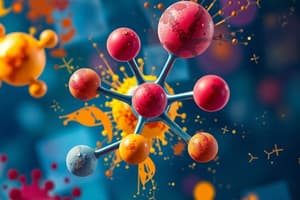Podcast
Questions and Answers
What is biochemistry?
What is biochemistry?
The study of the chemical substances found in living organisms and the chemical interactions of these substances.
What are the two major types of biochemical substances?
What are the two major types of biochemical substances?
- Bioorganic Substances (correct)
- Bioinorganic Substances (correct)
- Organic Compounds
- Synthetic Substances
Match the following biochemical substances with their examples:
Match the following biochemical substances with their examples:
Bioinorganic Substances = Water, Inorganic Salts Bioorganic Substances = Carbohydrates, Proteins, Lipids, Nucleic Acids
What percentage of the human body is made up of water?
What percentage of the human body is made up of water?
Bioorganic molecules make up more than one-fourth of body mass.
Bioorganic molecules make up more than one-fourth of body mass.
What constitutes about 4%–5% of body mass?
What constitutes about 4%–5% of body mass?
Flashcards are hidden until you start studying
Study Notes
Overview of Biochemistry
- Biochemistry studies chemical substances in living organisms and their interactions.
- It encompasses discoveries about how cells create essential life molecules and maintain chemical reactions.
Major Types of Biochemical Substances
-
Bioinorganic Substances:
- Do not contain carbon.
- Includes water and inorganic salts.
-
Bioorganic Substances:
- Contain carbon.
- Comprises carbohydrates, proteins, lipids, and nucleic acids.
Composition of the Human Body
- Water accounts for approximately 70% of human body mass.
- Proteins contribute around 15% of body mass.
- Inorganic salts make up about 5% of body mass.
- Lipids constitute roughly 8% of the body mass.
- Carbohydrates and nucleic acids each represent about 2%.
Importance of Biochemical Interactions
- Despite a predominance of organic substances, bioorganic molecules constitute only about one-fourth of body mass.
- Bioinorganic substances, especially water, are critical for sustaining life.
- Isolated biochemical substances are lifeless; however, their interactions within cells support life processes.
Studying That Suits You
Use AI to generate personalized quizzes and flashcards to suit your learning preferences.




